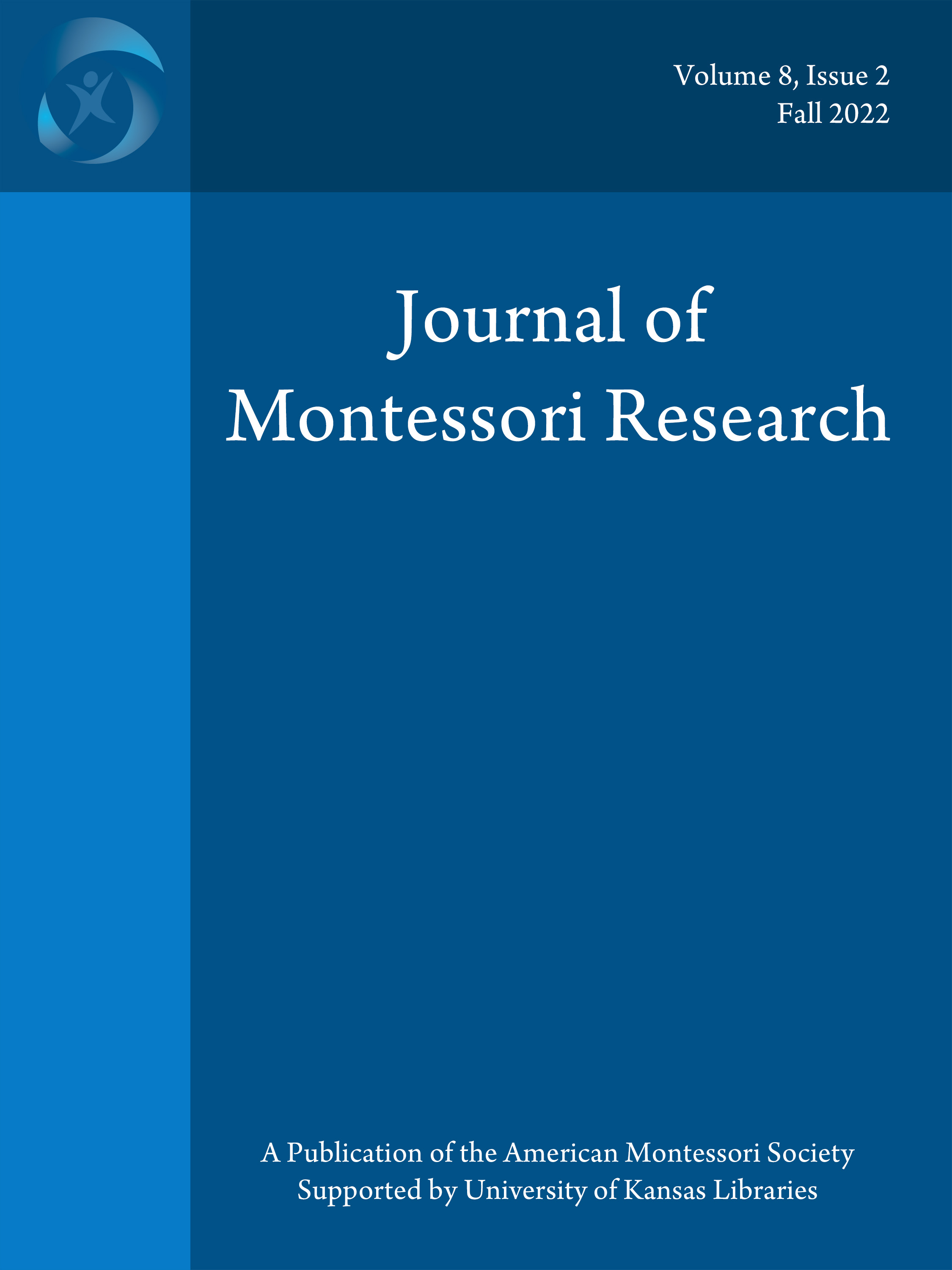Global Diffusion of Montessori Schools
A Report From the 2022 Global Montessori Census
DOI:
https://doi.org/10.17161/jomr.v8i2.18675Keywords:
Montessori Census, Montessori research, global education, alternative pedagogyAbstract
Montessori education is distinct for its implementation in 154 countries around the world. Lacking a Montessori trademark or comprehensive overseeing body, the expansion of the Montessori approach has often been diffuse and fragmented among competing organizations. The absence of centralized, accurate, and consistent accounting has made it difficult to document the scope, growth trends, and diverse populations of students served in Montessori schools. The primary objective of this study was to gather evidence to support a robust estimate of the number of Montessori schools worldwide. This estimate relies on national and regional organizations’ broadest definitions of what constitutes a Montessori program. The study included two components: a survey of regional and national Montessori organizations and supplemental sources, including other published estimates and direct inquiries within key countries. Multiple sources allowed for triangulating data to reach a more confident estimate for the number of schools in each country and for synthesizing global perspectives on significant elements of Montessori fidelity worldwide. Through these sources, we document a total of 15,763 Montessori schools around the globe, roughly 9% of which are government funded. Countries with the largest number of Montessori schools are the United States, China, Thailand, Germany, Canada, and Tanzania; the United States, Thailand, the Netherlands, and India have the largest number of government-funded or public Montessori programs. Results of the fidelity analysis identified six practices that emerge consistently as central pillars of Montessori implementation.
References
Association Montessori Internationale (AMI). (2021). 2021 Annual Report. https://montessori-ami.org/news/2021-annual-report
AMI. (2020). Montessori countries in 2020. Annual General Meeting [remote].
Association Montessori Internationale (AMI). (2006). Montessori Worldwide. http://montessoricentenary.org/
Brouwer de, J., Mattijssen, E., & Stefels, M. (2022). Reflections on Montessori in the Netherlands: Fidelity—adaptation debate. In Perspectives on Montessori. De Brouwer, J. & Sins, P. H. M. (Eds). Saxion Progressive Education University Press.
Center for Guided Montessori Studies (CGMS). (n.d.). Global Montessori schools census. http://schools.guidedstudies.com/search/info.php
Debs, M. (in press). Introduction: Global Montessori education. In Handbook of Montessori Education. Murray, A. K., Ahlquist, E-M. T., McKenna, M., & Debs, M. (Eds). Bloomsbury Publishing. [Publication date April 6, 2023]
Denervaud, S., Christensen, A. P., Kenett, Y. N., & Beaty, R. E. (2021). Education shapes the structure of semantic memory and impacts creative thinking. npj Science Learn, 6(35).
Gasco-Txabarri, J., & Zuazagoitia, D. (2022). The sense of patterns and patterns in the senses. An approach to the sensory area of a Montessori preschool classroom. Education, 3–13. https://doi.org/10.1080/03004279.2022.2032786
Gutek, G. L., & Gutek, P. A. (2016). Bringing Montessori to America: SS McClure, Maria Montessori, and the campaign to publicize Montessori education. University of Alabama Press.
International Baccalaureate (IB). (2020). Facts and figures. https://www.ibo.org/about-the-ib/facts-and-figures/
Kramer, R. (1976/1988). Maria Montessori: a biography. Addison Wesley.
Landi, L., & Pintus, A. (2022). A critical approach to the Reggio Emilia Approach. Educazione. Giornale di pedagogia critica, 11(1).
Lillard, A. S., & McHugh, V. (2019). Authentic Montessori: The Dottoressa’s view at the end of her life part I: The environment. Journal of Montessori Research, 5(1), 1–18.
Livstrom, I. C., Szostkowski, A. H., & Roehrig, G. H. (2018). Integrated STEM in practice: Learning from Montessori philosophies and practices. School Science and Mathematics, 119, 190–202.
Macy, M., Pool, J., Chen, C. I., Rusiana, T., & Sawyer, M. (2021). A preliminary examination of a kindergarten school readiness assessment. Early Childhood Education Journal, 50, 1035–1046.
Marshall, C. (2017). Montessori education: A review of the evidence base. npj Science of Learning, 2(11), 1–11.
Montessori Aotearoa New Zealand. (2022). Montessori in Aotearoa New Zealand. https://www.montessori.org.nz/montessori/montessori-new-zealand/
Murray, A. K., & Daoust, C. (in press). Fidelity issues in Montessori research. In Handbook of Montessori Education. Murray, A. K., Ahlquist, E-M. T., McKenna, M., & Debs, M. (Eds). Bloomsbury Publishing. [Publication date April 6, 2023]
National Center for Montessori in the Public Sector (NCMPS). (n.d.). Montessori census. https://www.montessoricensus.org/
North American Reggio Emilia Alliance. (2022). Census. https://www.reggioalliance.org/census/
Opera Nazionale Montessori. (n.d.). Nidi e Scuole Montessori in Italia. https://www.operanazionalemontessori.it/nidi-e-scuole-montessori/nidi-e-scuole-montessori-in-italia
Povell, P. (2009). Montessori comes to America: The leadership of Maria Montessori and Nancy Mccormick Rambusch. University Press of America.
Qualtrics. (2021). Translate survey. https://www.qualtrics.com/support/survey-platform/survey-module/survey-tools/translate-survey/
Quarfood, C. (in press). Maria Montessori: Life and historical context. In The Bloomsbury Handbook of Montessori Education. Murray, A. K., Ahlquist, E-M. T., McKenna, M., & Debs, M. (Eds). Bloomsbury Academic.
Reggio Emilia Approach. (2022). Network. https://www.reggiochildren.it/en/reggio-emilia-approach/network-en/
South African Montessori Association. (2022). SAMA schools. https://samontessori.org.za/category/sama-schools/
Waldorf Worldwide Organization/Freunde der Erziehungskunst Rudolf Steiners. (n.d). Waldorf World list. https://www.freunde-waldorf.de/en/waldorf-worldwide/waldorf-education/waldorf-world-list/
Whitescarver, K., & Cossentino, J. (2008). Montessori and the mainstream: A century of reform on the margins. Teachers College Record: The Voice of Scholarship in Education, 110(12), 2571–2600. https://doi.org/10.1177/016146810811001202
Downloads
Published
Issue
Section
License
Copyright (c) 2022 Mira Debs, Jaap de Brouwer, Angela K. Murray, Lynne Lawrence, Megan Tyne, Candice von der Wehl

This work is licensed under a Creative Commons Attribution-NonCommercial 4.0 International License.


